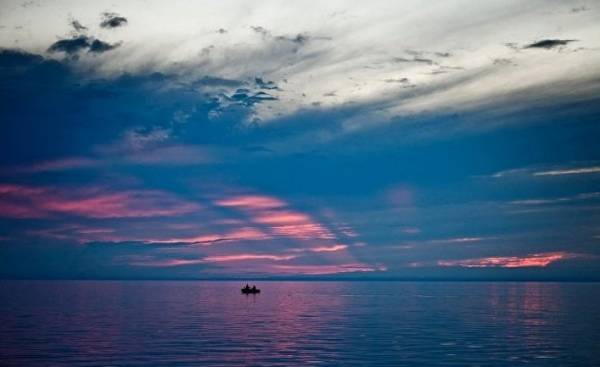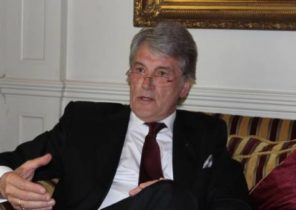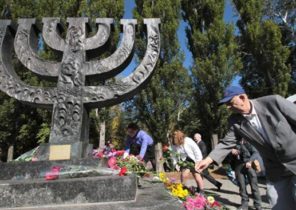
NEW HAVEN- Last winter, standing on top of granite rocks in Siberia, I saw that 100 years ago became the first object of the world’s largest system of protected natural territories of the world. To the West of me glittered the Baikal lake more than a mile (1642 meters) in depth. To the East towered the snow-capped peaks, one of which reminded me of sharp the top of the rock Half dome, the symbol of Yosemite national Park in the United States. Before my eyes stretched the Barguzin nature reserve, a protected area under the protection of which is more than 600,000 acres free from human impact areas where ordinary people trespassing.
After Barguzin one by one appeared 103 reserve protects 68 million acres of Russian land. Most of them are rooted in the Soviet era and support the world’s highest level of protection of large areas within the state under the qualification of “natural territorial complexes”, prepared by the International Union for conservation of nature and natural resources.
How Russia — which hardly can be called the cradle of conservation activities, given the accelerated program of industrialization Joseph Stalin — managed to become a pioneer on an international scale in the field of nature protection and rational use of natural resources?
It all began with Vladimir Lenin. In 1919, a young agronomist named Nicholas podjapolsky has passed the way from the Volga Delta, where hunters almost completely destroyed many fauna species, in Moscow to meet with Lenin. Standing before the leader of the Bolsheviks with the aim of obtaining approval for the construction of a new sanctuary, pod’yapol’skii felt a strong excitement, “as if before an exam in school.” However, Lenin, as a longtime fan of Hiking and trekking, agreed that the protection of nature — “important and urgent”.
Two years later, Lenin signed a law on the protection of nature monuments, gardens and parks across the continent. For three decades, about 30 million hectares (an area of 40 States Rhode island) from the European peaks of the Caucasus to the Pacific volcanoes of Kamchatka have been attributed to consisting of 128 reserves system.
The history of reserves related to religion. For many years the priests were overshadowed woods cross, disclosing the commandment imposing a ban on their felling. By the beginning of the 20th century the divine side of the issue began to resonate with science: humanity is exterminated “primordial nature”, as in 1908, said at a conference in Moscow biology Professor Grigory Kozhevnikov. He argued that human dominance will soon deprive humanity of the opportunity to contemplate nature in any other way besides artificial imitation, “blurring the image of a vanished past.”
He speculated on the need to preserve Russia’s vast territories where “nature should be left alone”. They had become venues for recreation and entertainment of the person (as mentioned in the law on the establishment of the first national parks in America, about which the Russians knew), and the standard process of studying intact natural systems.
In the early 1920-ies in the Moscow zoo was organized by the circle of young biologists, many of whom became leaders of the Communist environmental movement by establishing an extensive network of nature reserves such as created in the 1935 Pacific coastal reserve for conservation of the Amur tiger.
But Joseph Stalin was not one of those who obeys the orders of a stranger. In the 1940s, he proposed “the great plan of transformation of nature” of the USSR. In 1951 with the purpose of development of agriculture, cattle breeding, forestry, mining and hunting, he reduced the number of reserves by 89%, leaving only 40 to which there were about 3.5 million hectares of land.
After Stalin’s death in 1953 the brave scientists decided to return to the protection of protected areas. By 1961, the system had expanded to 93 reserves of 15.7 million acres, adding several new and restored many old ones.
The successor to Stalin, Nikita Khrushchev did not belong to number of supporters of environmental activities, forcing the latter to rally even stronger. Its survival reserves are required, in particular, the law in 1960 to encourage “the participation of NGOs in nature protection”. Within days, a group of students-biologists of Moscow state University took the challenge. Calling their movement “a Team” (in honor of the medieval warriors that were defending their homeland from invaders who sought to destroy the Christian faith in Russia), they began to fight poachers and to create reserves.
The motto of the students gave an ironic romanticism, “the success of a hopeless case!” In the 1980s, in the country there are about 140 teams, “teams”. The years went by, and the activists became leaders of the teaching staff of universities, environmental organizations and staff of the Ministry of natural resources of Russia.
During a hike on the rock located in the immediate vicinity of the protected open spaces of the Barguzin reserve, my guide was a member of the “Team” named Irina Kurkina. The first Russian nature reserve was established in January 1917, before the seizure of power by the Bolsheviks (Lenin proposed a young agronomist reserve in the Volga Delta was the second). Ms. Kurkina came here in 1986, having escaped from the poultry farm, where the government sent her immediately after graduation. Now she lives here, deep in southern Russia, where it is not paved any roads.
According to her, she wouldn’t have to live and work in this place, if not like-minded in the Moscow “Squads”, whose names she listed throughout our ascent.
Their work was fraught with risks. For the anti-poaching team “Squad” was given the legal right to make arrests of citizens. In the period between the early 1970s and mid-1980s from poachers killed at least three activists — from the Black sea, in the Ural mountains and near lake Baikal.
In addition to threats of physical violence, there were also political. A few years ago, a specialist on anti-poaching Vsevolod Stepanitsky told me about one of his shifts, during which they are classmates and detained in the suburbs of illegal hunters for ducks. One of them, as it turned out, was the “Deputy Minister of Finance.” Worried about the possible reaction to your report, the students presented the available evidence of the Communist party.
The Minister then got off with a reprimand, recalled Stepanitsky, and the students rejoiced, as to punish them no one. According to another activist who later joined the biology faculty of Moscow state University, “Squad” was “the prototype of civil initiatives” and, as she put it, “a symbol of democratization in the conditions of totalitarianism.”
After graduation, Stepanitsky, along with many members of the “Militia” became a researcher reserves, having started his career in 1982 at the Pacific coast of Russia. In late 1991, when the Soviet Union collapsed, he became the head of Management of especially protected natural territories of the newly formed Russian Federation. Despite the economic difficulties, he and his colleagues took the initiative and in four years has established 18 new reserves, including on the beautiful commander Islands in the Aleutian district, Kamchatka Krai.
In Russia environmental protection activities remains one of the most pressing problems. Three times in the first 20 years of its post-Soviet leadership Stepanitsky has resigned in protest against administrative problems, including the efforts to make the protected resources in the financial. The second time he resigned in 2002, when an official of the Ministry of natural resources ordered the Directors of reserves to start to profit from deforestation in the territories under their control. Work, according to Stepanikova, was akin to “March to the rear of the enemy.”
Every time Stepanitsky corners of the government, helping environmental organizations and supporting the members of the movement for the protection of the environment. And every time, as, apparently, a silent recognition of common sense and initiative of Mr. Stepanikova — the Russian government asked him to return to managing the Park system.
In 2015, President Vladimir Putin, who, as we know, never misses an opportunity to take pictures with tigers, bears and whales, announced in 2017, the centennial anniversary of Russia’s reserves, “the year of specially protected natural territories”. And the government was committed for the next eight years to increase the area of protected Russian territories by 18%.
But dark clouds have already thickened. Salaries of foresters, the improvement which fought Stepanitsky, amount to about 4,300 dollars per year. New ski resorts, funded by wealthy corporations, which, according to Russian environmental groups lobbied the government, threatened, apparently, to the Caucasian reserve. Although Mr. Stepanitsky and encourages cultural tourism in small areas of nature reserves, ski design, he criticized as not having anything in common with ecotourism and is able to compromise supported by President Putin and the reintroduction of the leopard.
And over the first Russian nature reserve in the Arctic, Wrangel island, were in danger from the new military base. On Russian TV recently showed a terrible story about how one of the builders of the lure of the polar bear, and then threw him instead of eating a firecracker that exploded the animal’s mouth. It is now proposed a bill that would authorize the President of Russia to deprive nature reserves conservation status for any reason, including in order to “ensure the security of the state”.
In April, Mr. Stepanitsky left his post for the fourth time. Conservationists throughout Russia follow his unrestrained comments, in particular that the Ministry considers the nature reserves of Russia “resource that can be used for leisure and entertainment.” He unleashed a barrage of criticism at the government for failing to maintain the centuries-long “Holy idea” of the system.
However, at the moment the legacy of Lenin can be saved, and in the protection of their territories, Russia is still the world leader, ahead of Brazil and Australia. Russian scientists continue to defend their not so hopeless a case for conservation on this planet a few extensive natural areas, where no foot of man.
Fred Stripe is a senior lecturer in the school of forestry and environmental studies at Yale University. His non-fiction works cover a wide range of issues, in particular, the Movement of arts and crafts in America, bicycles and their role as cultural forces of China exchange in the field of education between China and the United States, the creation of a dictionary of American dialects, pressures in relation to the Antarctic Treaty, the natural and social conditions in the Falkland Islands, the race for the creation of radar during the Second World War, the traces of ancient man in South Africa, the growing influence of feminist law, saving whales from fishing nets off the coast of Newfoundland, the impact of environmental issues on the presidential election of 2004 and the protection of the world’s largest system of scientific nature reserves in Russia. His works have been published in various publications, including Atlantic Monthly, Audubon, E-The Environmental Magazine, Legal Affairs, New Republic, Reader’s Digest, Russian Life, Sierra, Smithsonian and the New York Times Magazine.







